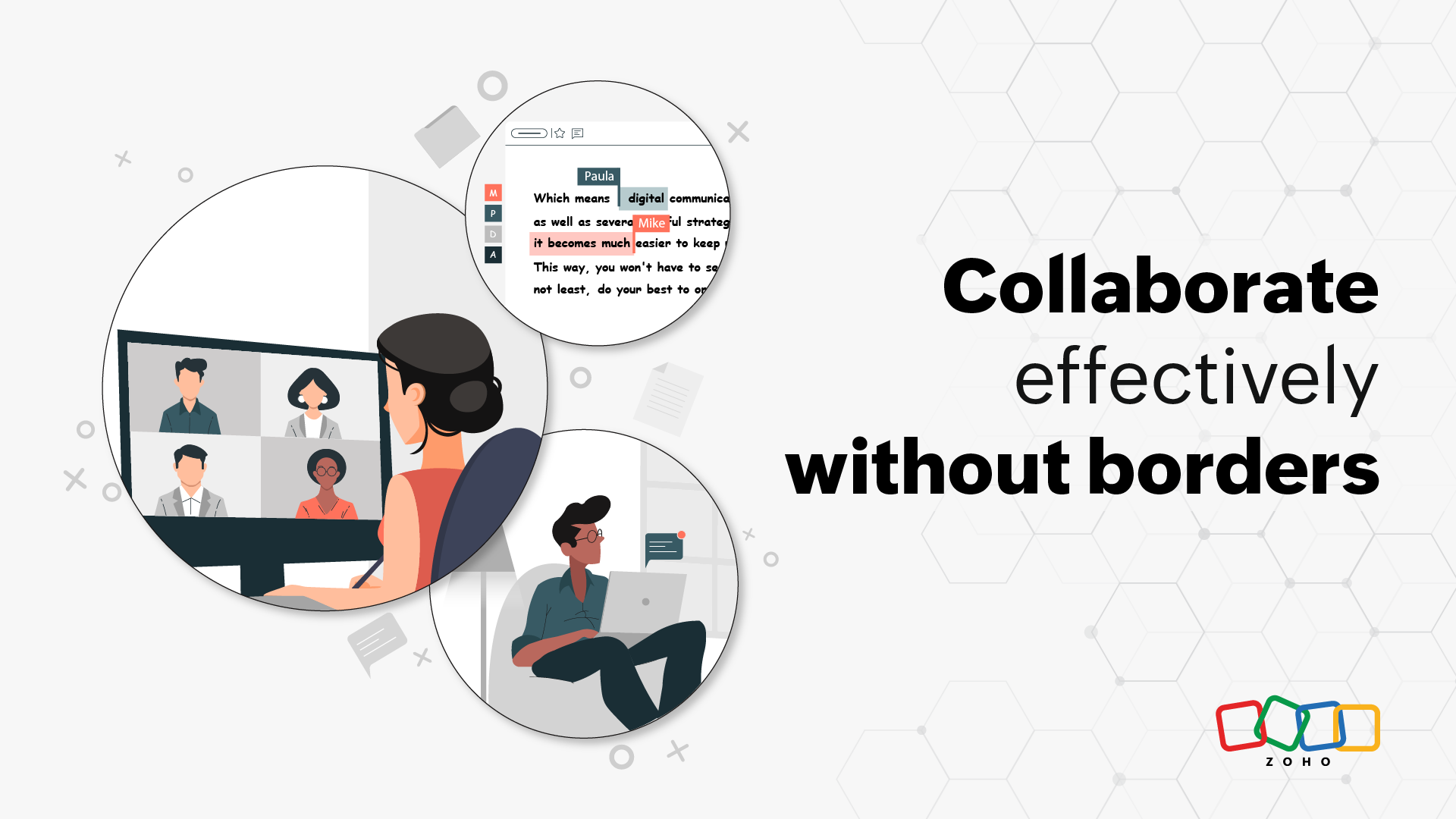- HOME
- All Topics
- Productivity in the workplace
- Cultivating effective cross-team collaboration for hybrid teams
Cultivating effective cross-team collaboration for hybrid teams
- Published : November 30, 2023
- Last Updated : October 17, 2024
- 900 Views
- 5 Min Read
Imagine this: A company launches a new product. The product team is responsible for developing the product, but they need help from other teams in the company to launch it successfully.
For example, the marketing team helps bring the product to market and promote it, the sales team finds customers who will buy the product and generate revenue, and the customer support team delivers support to the customers whenever they need it.
Only by collaborating effectively can the three teams create a product that meets the needs of their customers and achieve the company's goals.

What is cross-team collaboration?
Cross-team collaboration is the practice of bringing together people from different teams or departments to work on a common goal. It can be a powerful tool for creating new thinking and ideas, improving productivity, and fostering innovation.
Why do we need cross-team collaboration?
A company's overall success is not determined by the individual services or departments, but by the optimal coordination of all areas, teams, and employees. Here are some of the advantages of cross-team collaboration:
Improved communication
Cross-team collaboration can help break down silos and improve communication between different departments. This can lead to a better understanding of the needs of each department and a more cohesive approach to problem-solving.
Faster innovation
Cross-team collaboration can bring together different perspectives and ideas, leading to new and innovative solutions. When people from different backgrounds with different experiences work together, they can come up with creative solutions that any one person would have struggled to come up with on their own.
Improved productivity
Cross-team collaboration can help streamline processes and improve efficiency. When people from different departments work together, they can share resources and expertise, leading to faster and more efficient results.
Increased employee engagement
When employees feel like they're part of a team and that their work is making a difference, they're more likely to be engaged and satisfied with their jobs.
Cross-team collaboration in a hybrid environment
In today's post-Covid business world, hybrid teams have become the norm. With team members spread across different locations, time zones, and cultures, it's become imperative to establish effective communication and collaboration channels for seamless cross-team operations. Cross-team collaboration is key to unlocking the full potential of hybrid teams.
However, in a hybrid model, various challenges can arise in cross-team collaboration that include:
"It takes forever to get everyone into a meeting!"
With team members located in different time zones and working on different schedules, it can be difficult to find a time that works for everyone to meet. Even when meetings are scheduled, technical issues can arise that prevent remote team members from fully participating, leading to feelings of exclusion and frustration.
"We're doing more!"
Another challenge is building and maintaining trust. In-person team members may feel that remote team members aren't pulling their weight or aren't as invested in the project. On the other hand, remote team members may feel left out of important decisions or feel that their contributions are being overlooked. This can lead to resentment, mistrust, and a lack of cohesiveness within the team.
"This isn't how I work!"
Different regions may have different work styles, communication preferences, and expectations regarding team dynamics. This can lead to misunderstandings, miscommunications, and conflicts that can hinder collaboration and productivity.
"But I don't have that app!"
Not all teams have access to the same technology, which can make it difficult to collaborate.
Tips for hybrid teams to collaborate better
It's essential to employ methods so that you can tackle these challenges and foster meaningful collaborations. Here are a few tips virtual teams can follow to leverage the strengths of both in-person and remote team members to achieve their goals and work together effectively.
Set clear expectations
When expectations aren't clearly stated, individuals may make assumptions about what's expected of them, leading to errors, missed deadlines, and unhappy outcomes. Clearly defining what's expected of individuals can prevent misunderstandings and confusion.
Create a shared workspace
A shared workspace, such as a cloud-based environment where employees can set tasks, attend calls, and work together on files, can help team members collaborate effectively and stay in the loop when various activities occur.
Communicate regularly
Regular communication allows people to stay connected, understand each other's needs and expectations, and collaborate effectively towards common goals. Use a variety of communication tools, like chats, meetings, and emails, to stay in touch with team members.
Hold regular meetings
Regular meetings ensure that everyone is on the same page and can exchange ideas, address concerns, and make important decisions together. They can help you stay in sync with team members and discuss progress while improving your bond with your teammates.
Celebrate successes
When the team achieves a goal, take the time to celebrate their success. By celebrating successes, we can boost morale and self-confidence, inspire others to strive for their own success, and create a positive and supportive environment.
Be flexible
Be willing to adapt your approach to collaboration as needed. Flexibility in managing hybrid teams means providing clear communication channels, establishing boundaries and goals, and setting expectations to ensure everyone is on the same page.
Tools to help with cross-team collaboration
In addition to competent management skills, the organization should also explore the tools required for hybrid teams to communicate and share ideas. According to one study, online collaboration tools scale up productivity by 30%.
With these tools, organizations can ensure that all employees, regardless of their location, have the same access to the information and resources needed to succeed and work together seamlessly.
Email is a powerful tool that can help hybrid workforces stay connected, collaborate, and be productive. Because emails can be threaded, all of the messages in a conversation are displayed in one place.
Also, emails can be used to assign tasks, schedule meetings, share files, and gather feedback, making it easy for everyone to keep track of what's happening. The advantages of email are plenty, making it the primary mode of communication in many organizations.
Instant messaging
Because it's accessible from multiple devices, instant messaging allows team members to communicate and share information in real-time across different time zones, which can help speed up the workflow.
A platform where you can form private groups to work together on a project, set reminders for tasks and events, and collaborate through audio/video calls will help turn ideas into reality faster.
Calendar
A calendar platform that multiple people can access and edit can be useful for teams that need to coordinate their schedules. These collaborative calendars can also be used to track tasks and deadlines and share information about upcoming events.
Meeting
A meeting platform provides a medium for teams to communicate and collaborate in real time, helping teams exchange ideas effectively.
By avoiding back-and-forth emails, meeting platforms enable teams to exchange ideas regardless of their location, help accomplish their goals faster, and foster a culture of teamwork and boost team spirit.
File storage
By employing a cloud storage platform, team members can work together effectively on files and get a holistic view of what's happening across teams. Multiple users can access and share files, ensuring that everyone is on the same page and working towards the specified goal.
Wrapping up
Cross-team collaboration can be a challenge, especially in a hybrid setup. However, it can also be very rewarding. When done well, with the right business technology, cross-team collaboration can lead to better decision-making, increased innovation, and improved efficiency.
 Prashanth
PrashanthPrashanth is a Senior Product Marketer in the Zoho Workplace team who focuses more on Workplace productivity and how teams can work better. He loves bringing a creative element to his work. He enjoys traveling, writing, reading, and playing badminton.


